
The Bottom Line
Introduction, Drive Specifications, Pricing & Availability
The Apacer Z280 is another in a lengthy list of Phison E7 powered SSDs to cross our bench. We've become fond of E7 controlled SSDs for several reasons. E7 Powered SSDs typically deliver an excellent SSD experience for less money than the competition. When you buy an Apacer Z280 SSD you are getting the goodness of an MLC flash array at TLC prices.
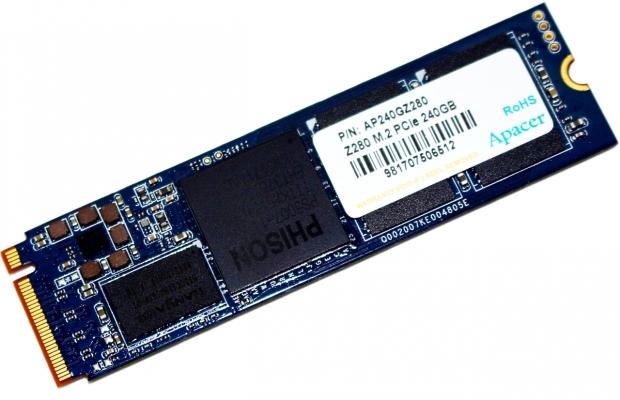
To this point, the Z280 is the first Phison E7 powered SSD we've reviewed that doesn't have an exposed controller die. We don't know if the capped die hurts or helps thermal dissipation, but we don't usually have thermal throttling issues with the E7 controller if it is running in a desktop computer with some airflow. The E7 controller does tend to heat up a bit more than others during write-intensive workloads, but we have yet to trigger thermal throttling which kicks in at 80c.
The Phison PS5007-E7 (or E7) is designed for high-performance computing applications. The E7 supports up to 8-channels in its NAND Flash interface so it is very fast. Multiple features are built into the Phison E7 controller to ensure stability and reliability. These features include SmartECC which reconstructs defective/faulty pages when regular ECC fails,
SmartRefresh monitors block ECC health status and refresh blocks periodically to improve data retention and SmartFlush minimizes time data spends in cache to ensure data retention in the event of power loss. Fast and reliable is what Phison's E7 controller is all about.
Let's get the Apacer Z280 on the bench and see how it does.
Specifications

The Apacer Z280 M.2 NVMe SSD is available in three capacities: 120GB, 240GB and 480GB. The 240GB model we have on the bench today sports the following specifications:
- Sequential Read: up to 2,750 MB/s
- Sequential Write: up to 1,500 MB/s
- Max 4K Random Read Speed: not listed
- Max 4K Random Write Speed: not listed
- Endurance: up to 349 TBW
- MTBF: 2 Million Hours
- Warranty: 3-Year Limited Warranty
- SMART
- TRIM
- Garbage Collection
The 240GB Apacer Z280 is currently selling at Newegg for the outstanding price of: $123.00
Drive Details
Apacer Z280 240GB M.2 NVMe PCIe SSD

The drive ships with minimal packaging. The front of the packaging has a window on it to directly view the drive. The drive's capacity, form factor and interface are given here.

The back of the packaging lists compatible OS's, part and serial numbers.

Inside of the packaging, the drive is protected by a clear plastic clam shell container.

The front of the PCB houses the drives Phison E7 controller, a 256MB DRAM cache package and two of the drives four 64GB 15nm Toshiba MLC flash packages.

The back of the PCB houses the remaining two 64GB flash packages.
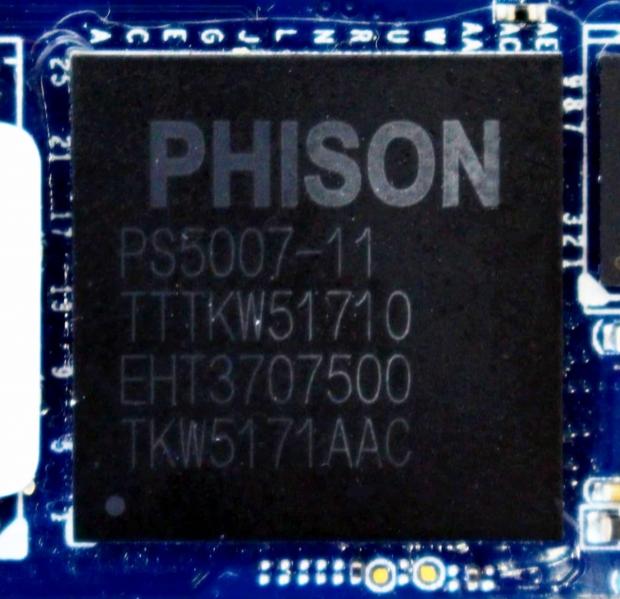
A close-in view of the drive's Phison PS5007-11 (E7) controller. As stated earlier, this is the first time we've seen a covered die on an E7 controller.
Test System Setup & Drive Properties
Jon's Consumer PCIe SSD Intel Review Test System Specifications
- Motherboard: ASRock OC Formula Z170 - Buy from Amazon / Read our review
- CPU: Intel Core i7 6700K @ 4.7GHz - Buy from Amazon / Read our review
- Cooler: Swiftech H2O-320 Edge - Buy from Amazon / Read our review
- Memory: Corsair Vengeance LPX DDR4 16GB 3200MHz - Buy from Amazon
- Video Card: Onboard Video
- Case: IN WIN X-Frame - Buy from Amazon / Read our review
- Power Supply: Seasonic Platinum 1000 Watt Modular - Buy from Amazon / Read our review
- OS: Microsoft Windows 10 Professional 64-bit - Buy from Amazon
- Drivers: MS Win 10 NVMe driver
Jon's Consumer PCIe SSD AMD Ryzen Review Test System Specifications
- Motherboard: ASUS Crosshair VI Hero
- CPU: AMD Ryzen 7 1800X @ 4.2GHz - Buy from Amazon / Read our review
- Cooler: Corsair Hydro H110i - Buy from Amazon
- Memory: Corsair Dominator Platinum DDR4 16GB 3000MHz - Buy from Amazon
- Video Card: XFX Radeon RX 460 Single Slot - Buy from Amazon
- Case: Corsair Carbide Air 540 - Buy from Amazon / Read our review
- Power Supply: Corsair RM850x 850 Watt Modular - Buy from Amazon
- OS: Microsoft Windows 10 Professional 64-bit - Buy from Amazon
- Drivers: MS Win 10 NVMe driver
We would like to thank ASRock, Crucial, Intel, Corsair, RamCity, IN WIN, and Seasonic for making our test system possible.
Drive Properties
Apacer Z280 240GB M.2 NVMe PCIe SSD OS Disk 75% Full (Intel)
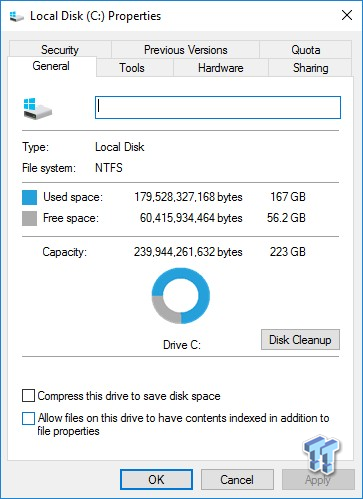
Apacer Z280 240GB M.2 NVMe PCIe SSD OS Disk 75% Full (AMD Ryzen)
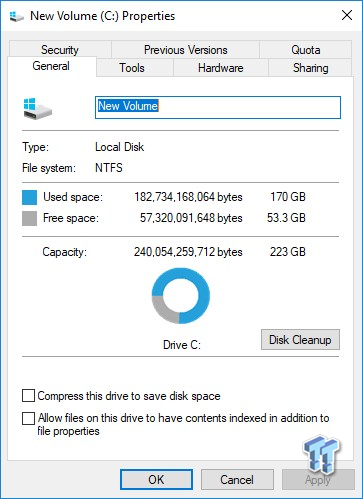
The majority of our testing is performed with our test drive as our boot volume. Our boot volume is 75% full for all OS Disk "C" drive testing to replicate a typical consumer OS volume implementation. We feel that most of you will be utilizing your SSDs for your boot volume and that presenting you with results from an OS volume is more relevant than presenting you with empty secondary volume results.
System settings: Cstates and Speed stepping are both disabled in our systems BIOS. Windows High-Performance power plan is enabled. Windows write caching is enabled, and Windows buffer flushing is disabled. We are utilizing Windows 10 Pro 64-bit OS (Build 14393) for all of our testing except for our MOP (Maxed-Out Performance) benchmarks where we switch to Windows Server 2012 R2 64-bit (Intel Only). Empty Windows 10 benchmark screenshots will also be shown on our MOP page for both Intel and AMD Ryzen Platforms.
Please note: When comparing our results to those of other review sites, look at page 10 Maxed Out Performance-Windows 10 which is done with the disk empty.
Intel screenshots will be shown first followed by AMD Ryzen throughout the review.
Synthetic Benchmarks – ATTO & Anvil Storage Utilities
ATTO
Version and / or Patch Used: 3.05
ATTO is a timeless benchmark used to provide manufacturers with data used for marketing storage products. When evaluating ATTO performance we focus on the drive's performance curve.
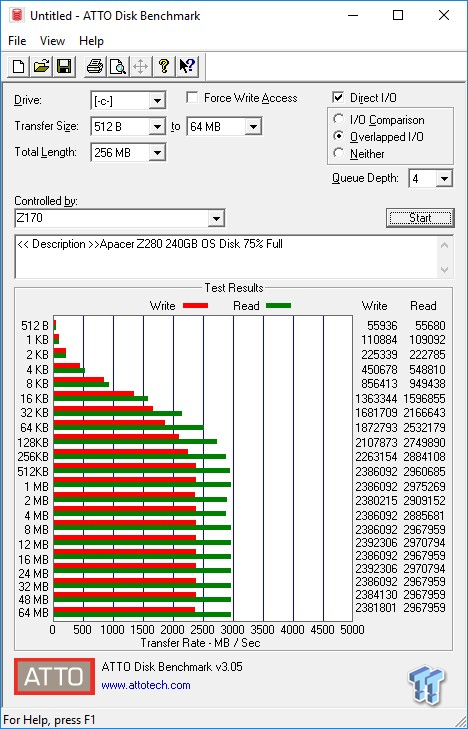
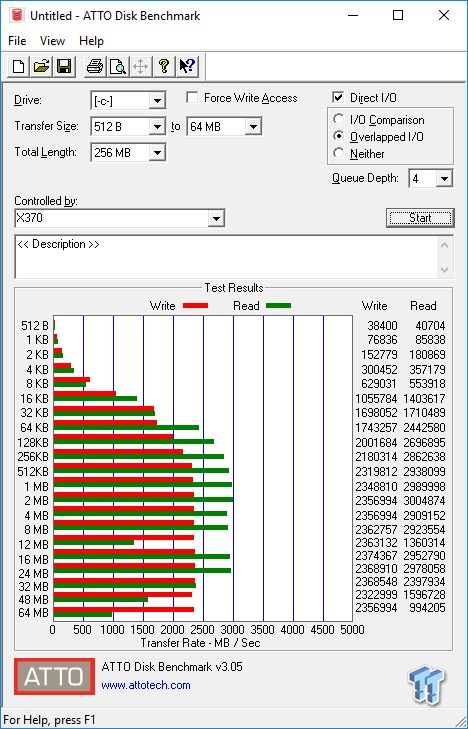
As we typically see, our Intel platform delivers far better small-file performance than our Ryzen platform. In the unlikely event that you are working with compressible data, the Z280, like all Phison E7 powered SSDs will deliver vastly superior write performance at 240GB.
Sequential Write
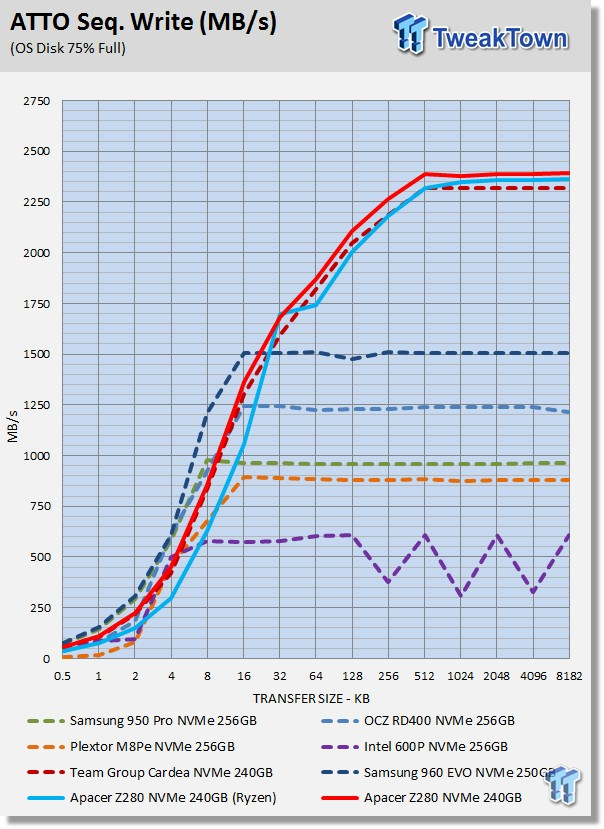
Graphing the performance curve shows stout performance on both platforms. It is important to note that E7 powered SSDs have an affinity for uncompressed data.
Sequential Read
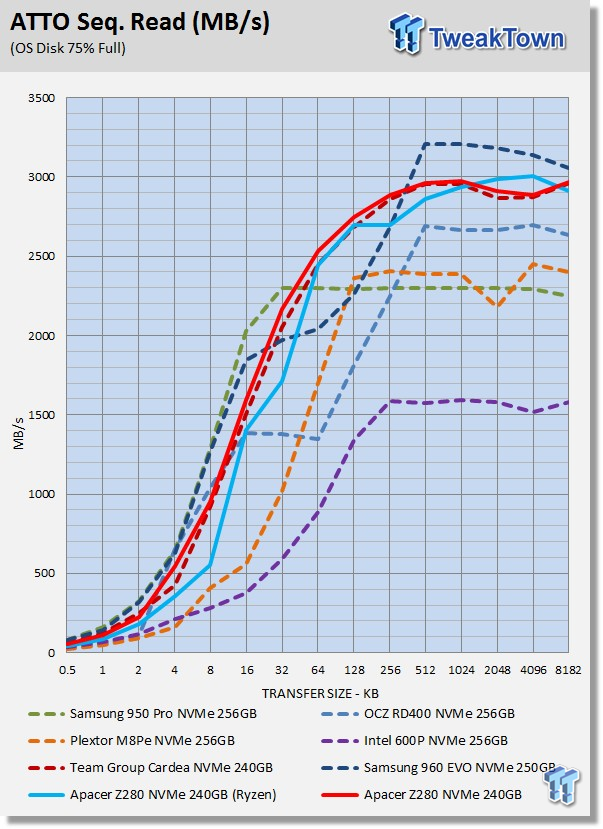
Here again, we see the Z280 delivering an excellent performance curve. The curve is considerable smoother on our Intel platform.
Anvil Storage Utilities
Version and / or Patch Used: 1.1.0
Anvil's Storage Utilities is a storage benchmark designed to measure the storage performance of SSDs. The Standard Storage Benchmark performs a series of tests; you can run a full test or just the read or write test, or you can run a single test, i.e. 4k QD16. When evaluating performance with Anvils, we focus on total score. When evaluating NVMe SSDs we are typically looking for a minimum total score of over 10K.
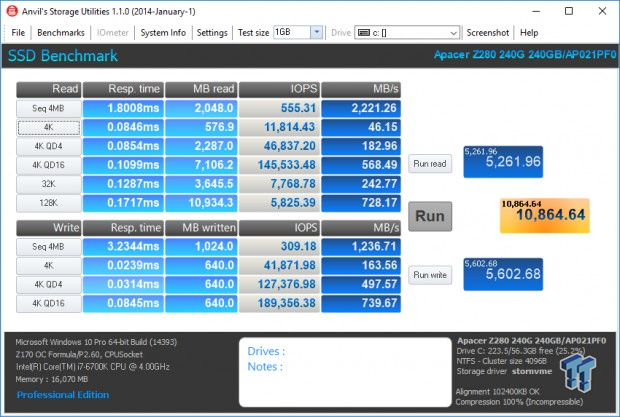
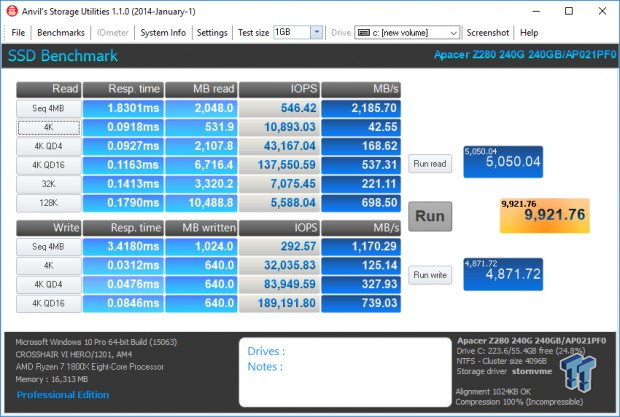
Scoring

The Z280 gives us a nice balance of read/write performance. It even manages to outperform the powerful OCZ RD400. The 960 EVO delivers a much higher total score, but most of that is coming from the write score. Comparing read scores shows the Z280 delivering slightly better-read performance than the 960 EVO. Comparing the Z280 to the Cardea, which is essentially the same drive, demonstrates that the Z280 is running on more effective firmware.
(Anvil) Read IOPS through Queue Depth Scale
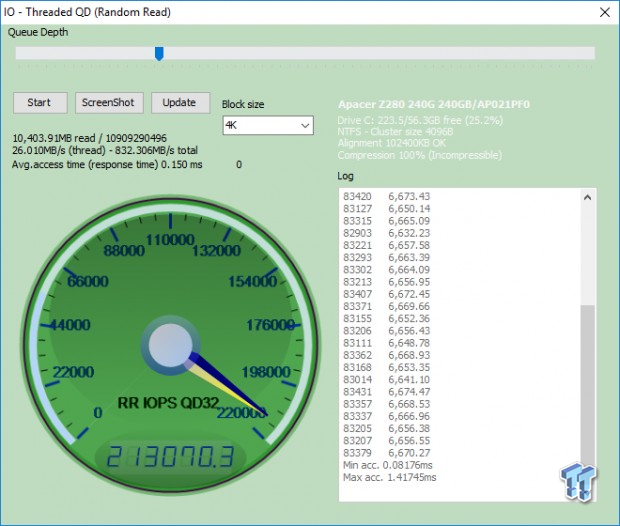
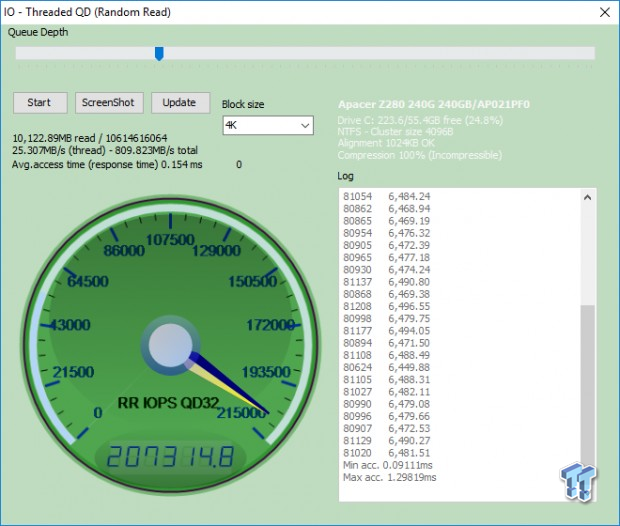
Both platforms easily exceed 200K random read IOPS at QD32. Keep in mind that this is our OS disk and it is 75% full.
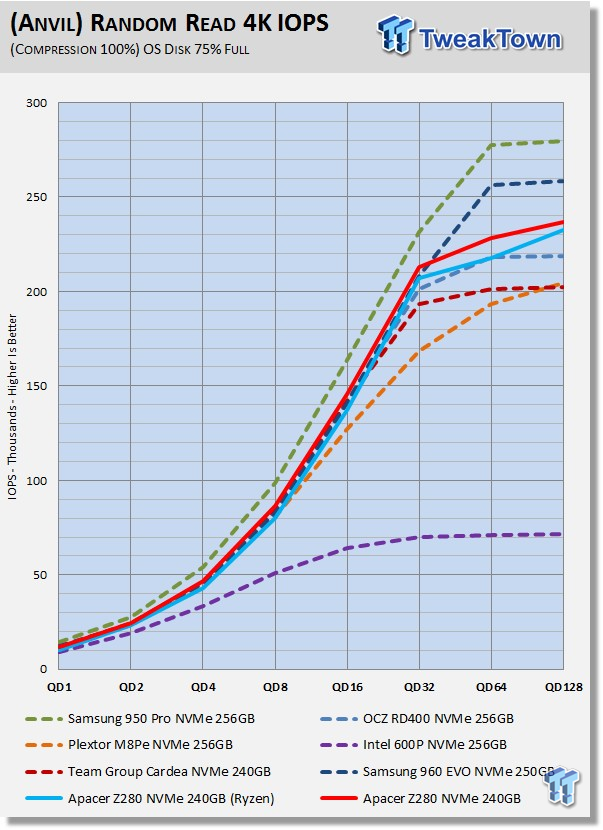
The Z280 really delivers the goods when reading data. Only the no longer available 950 Pro performs better. More importantly, the Z280 reads data better than the 960 EVO. Keep in mind that random read performance is much more important than random write performance.
(Anvil) Write IOPS through Queue Scale
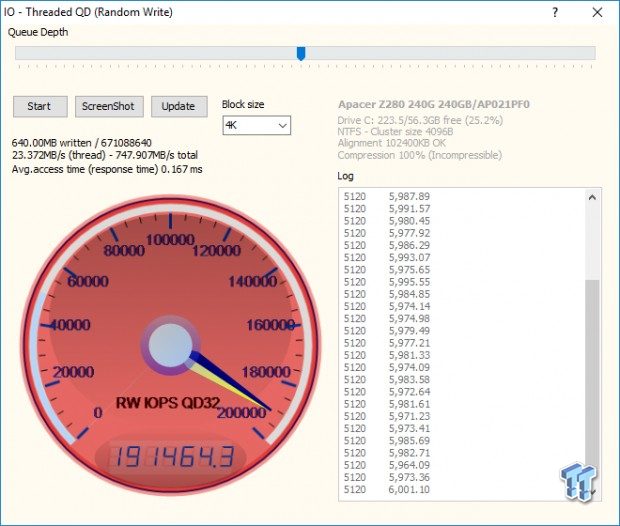
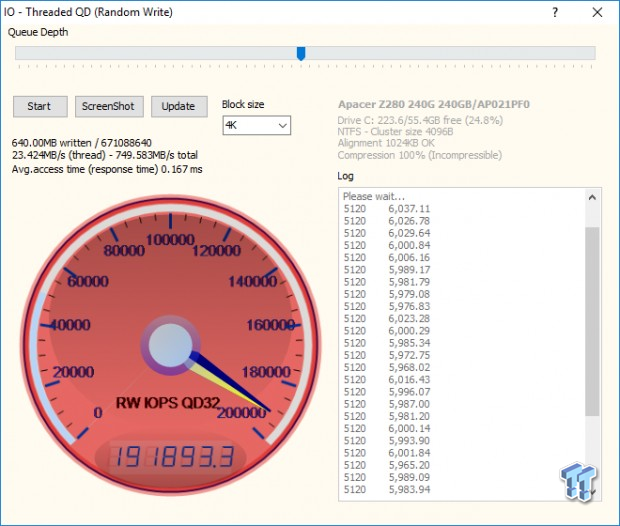
Both platforms exceed 191K random read IOPS at QD32. Keep in mind that this is our OS disk and it is 75% full.
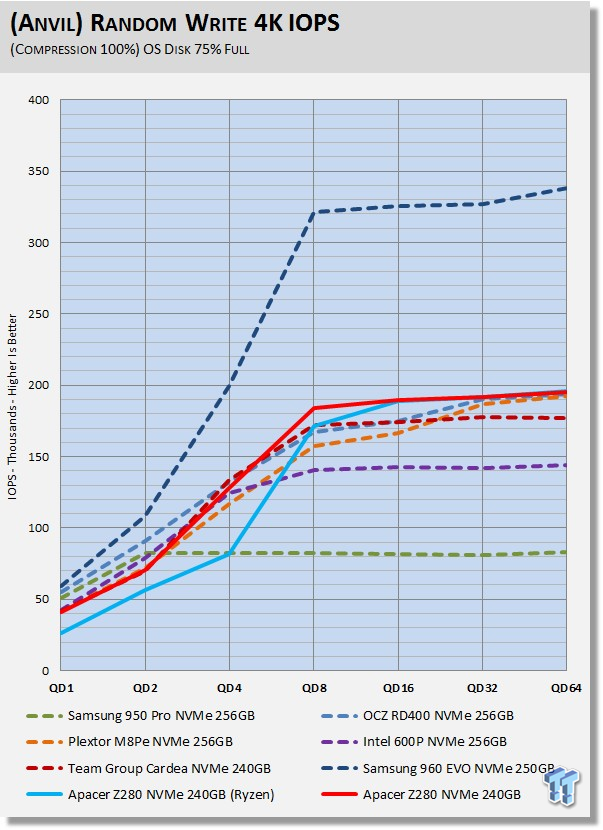
The Z280 is bringing up the rear on both platforms at QD1-2. We would like to see better random write performance from the Z280 at QD1-2.
Synthetic Benchmarks - CrystalDiskMark & AS SSD
CrystalDiskMark
Version and / or Patch Used: 3.0 Technical Preview
CrystalDiskMark is disk benchmark software that allows us to benchmark 4K and 4K queue depths with accuracy. Note: Crystal Disk Mark 3.0 Technical Preview was used for these tests since it offers the ability to measure native command queuing at QD4. When evaluating CDM results, we focus on 4K random performance at QD1 and QD4.
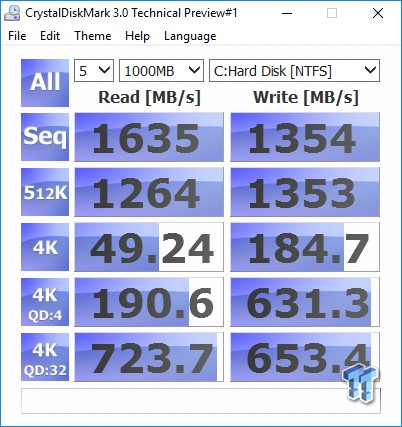
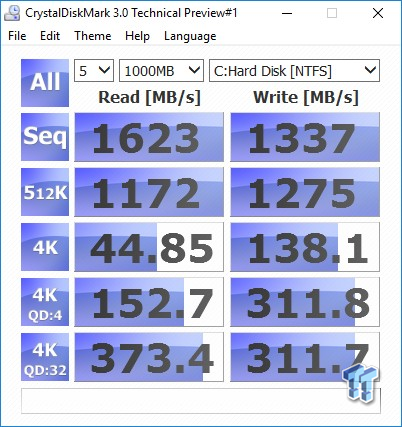
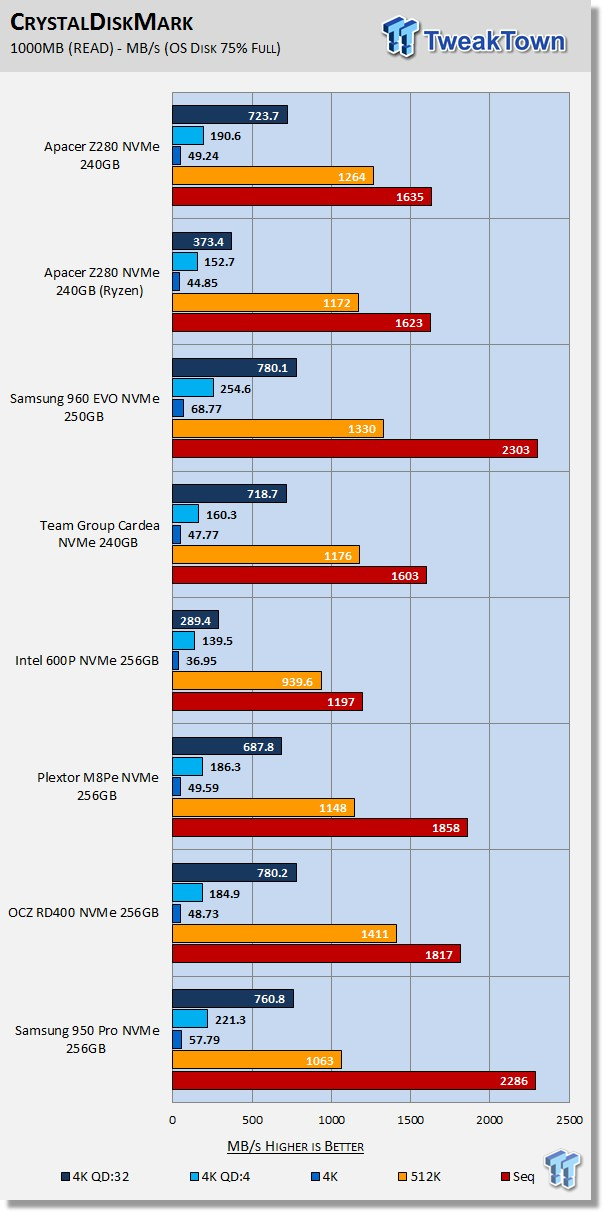
Focusing in on QD1 and QD4 reveals the Z280 outperforming most of the drives in our test pool when running on our Intel platform. Needless to say, the Z280 is very good at reading random data.
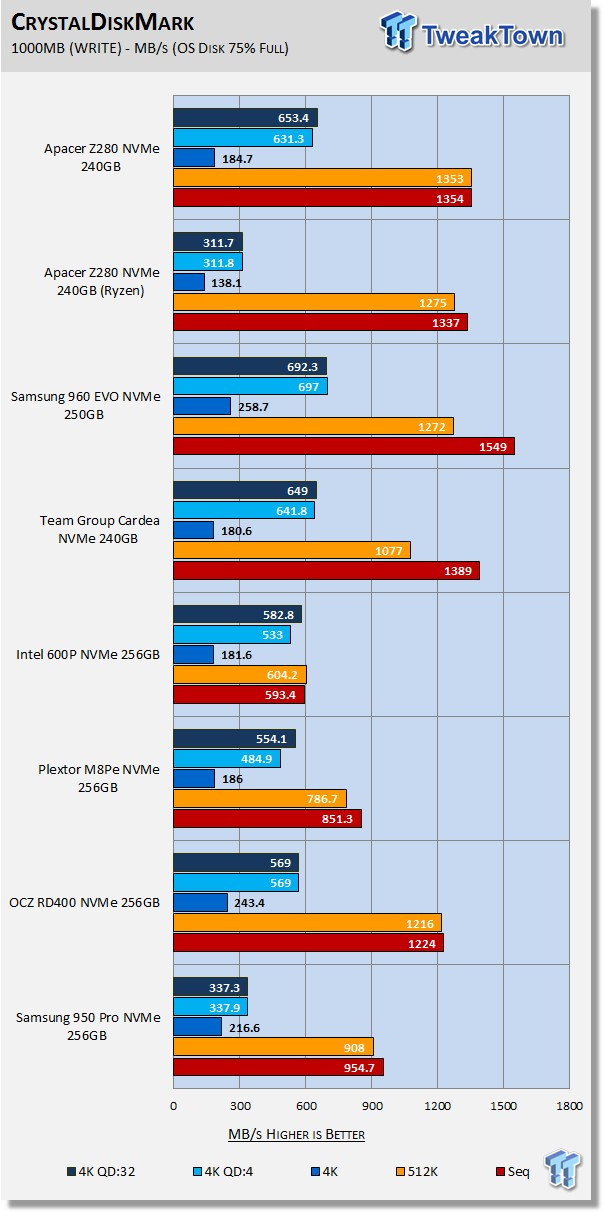
The AMD Ryzen platform is at a real disadvantage in comparison with Intel when writing random data. Looking at our Intel platform results, we find the Z280 delivering good results at QD1 and excellent results at QD4.
AS SSD
Version and / or Patch Used: 1.8.5611.39791
AS SSD determines the performance of SSDs. The tool contains four synthetic as well as three practice tests. The synthetic tests are to determine the sequential and random read and write performance of the SSD. We evaluate AS SSD performance in terms of overall score. We are looking for a minimum score of 2,000 when evaluating NVMe SSDs
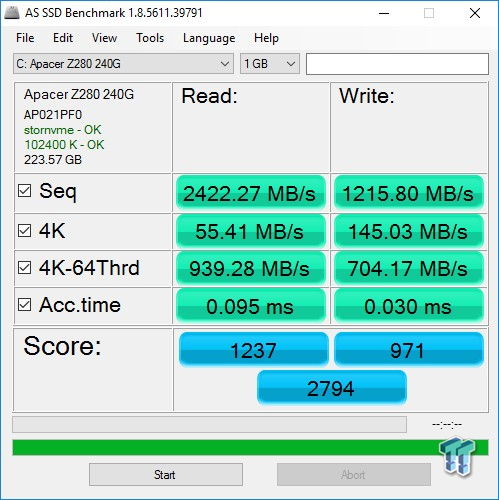
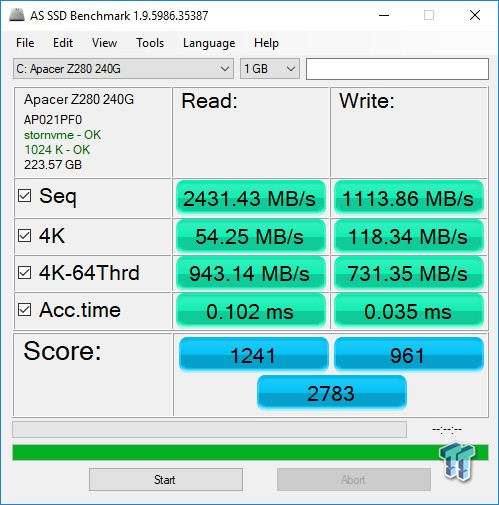
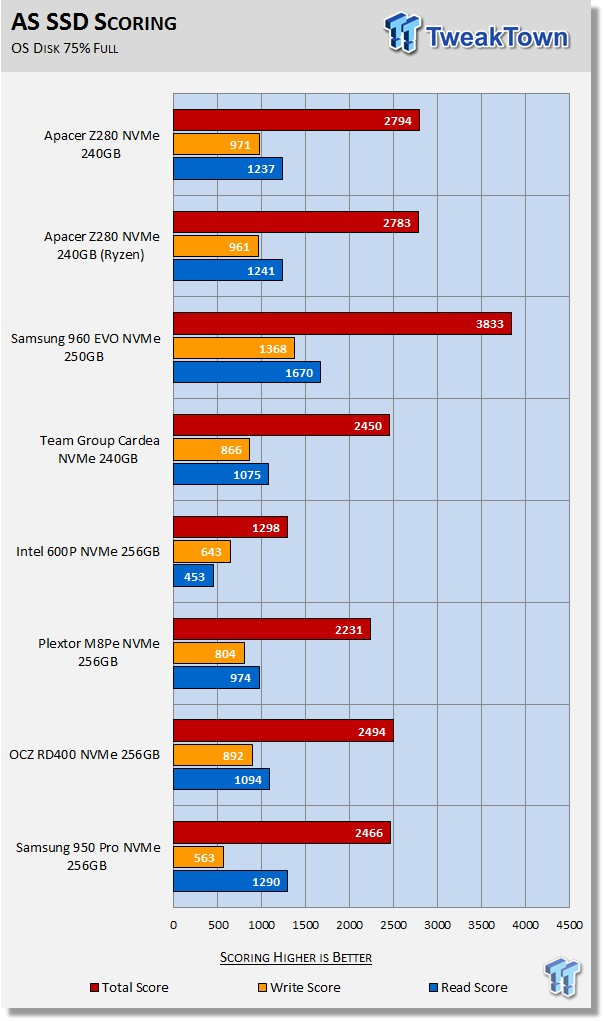
AS SSD is a demanding test, and the Z280 chews through it with ease. As we've seen all along, the firmware on the Z280 helps it deliver better performance than the Cardea, even though both drives are identical pieces of hardware.
Benchmarks (OS) - Vantage, PCMark 7, PCMark 8 & SYSmark 2014 SE
Moderate Workload Model
We categorize these tests as indicative of a moderate workload environment.
PCMark Vantage - Hard Disk Tests
Version and / or Patch Used: 1.2.0.0
The reason we like PCMark Vantage is because the recorded traces are played back without system stops. What we see is the raw performance of the drive. This allows us to see a marked difference between scoring that other trace-based benchmarks do not exhibit. An example of a marked difference in scoring on the same drive would be empty vs. filled vs. steady state.
We run Vantage three ways. The first run is with the OS drive 75% full to simulate a lightly used OS volume filled with data to an amount we feel is common for most users. The second run is with the OS volume written into a "Steady State" utilizing SNIA's consumer guidelines. Steady-state testing simulates a drive's performance similar to that of a drive that been subjected to consumer workloads for extensive amounts of time. The third run is a Vantage HDD test with the test drive attached as an empty, lightly used secondary device.
OS Volume 75% Full - Lightly Used
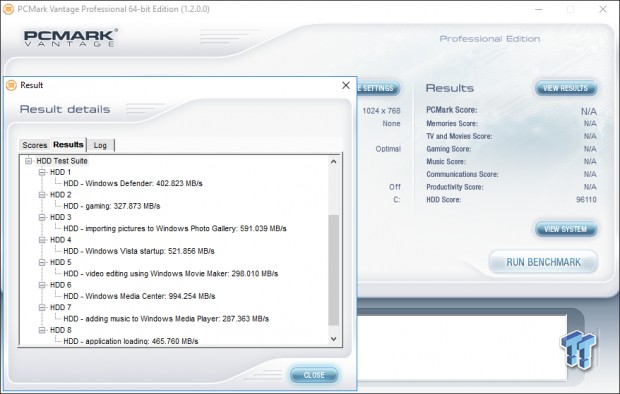
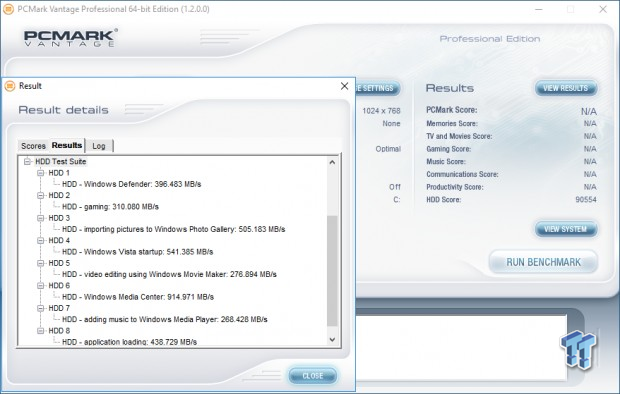
OS Volume 75% Full - Steady State
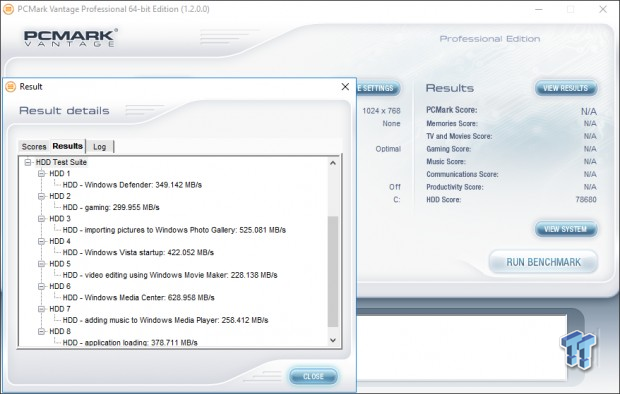
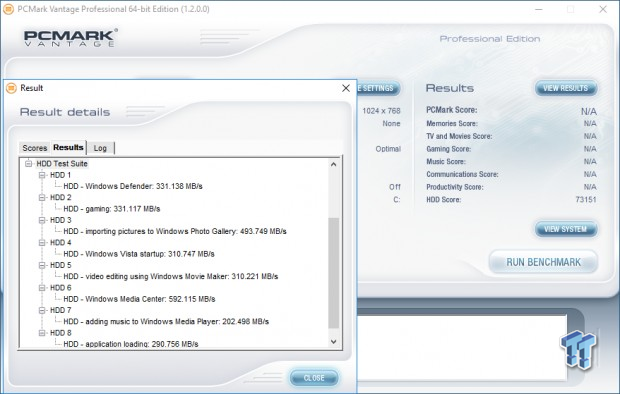
Secondary Volume Empty - FOB
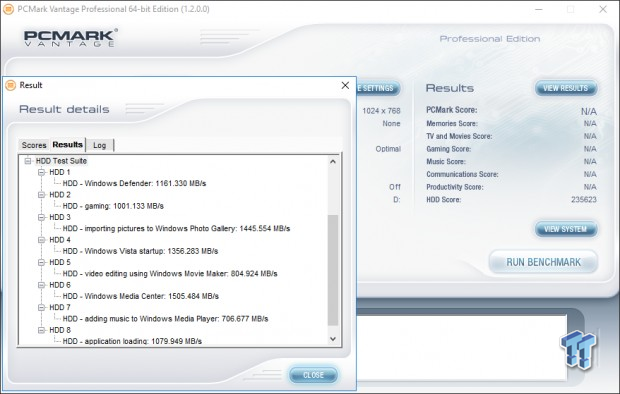
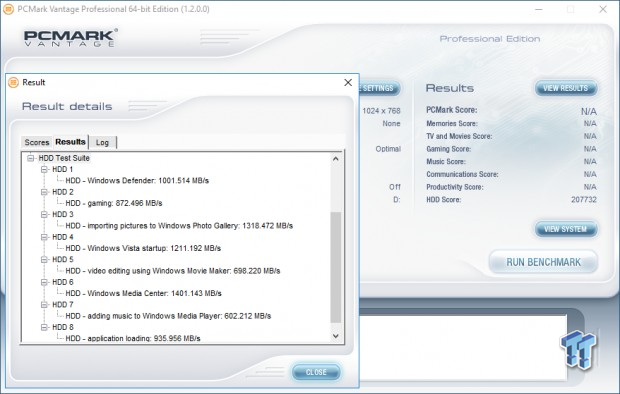
There's a big difference between an empty drive, one that's 75% full/used, and one that's in a steady state.
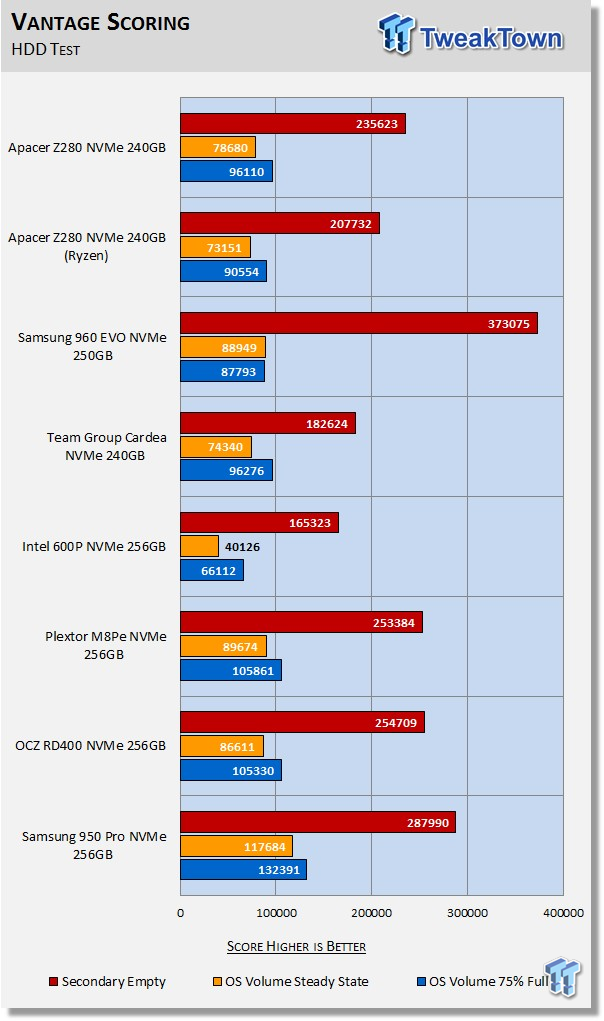
The important scores to pay attention to are "OS Volume Steady State" and "OS Volume 75% full." These two categories are most important because they are indicative of typical of consumer user states. When a drive is in a steady state, it means garbage collection is running at the same time it's reading/writing.
Focusing in on 75% full, we see that the Z280 running on both platforms can outperform the 960 EVO. Steady-state hits it pretty hard though.
PCMark 7 - System Storage
Version and / or Patch Used: 1.4.0
We will look to Raw System Storage scoring for evaluation because it's done without system stops and, therefore, allows us to see significant scoring differences between drives. When evaluating NVMe SSDs we are looking for a minimum score of 11,000.
OS Volume 75% Full - Lightly Used
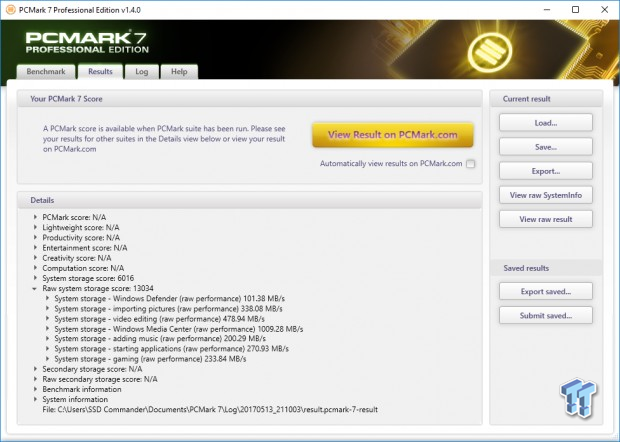
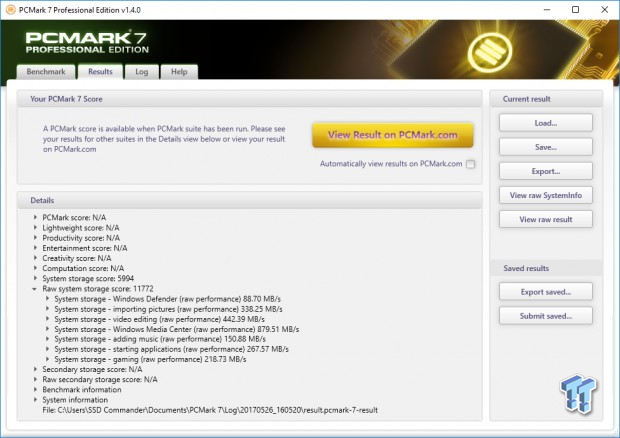

This is the first time we've seen an E7 powered SSD break 13K. Very impressive. The Z280 is showing itself to be a better choice for consumer workloads than the 960 EVO at this capacity point.
PCMark 8 - Storage Bandwidth
Version and / or Patch Used: 2.4.304
We use PCMark 8 Storage benchmark to test the performance of SSDs, HDDs, and hybrid drives with traces recorded from Adobe Creative Suite, Microsoft Office, and a selection of popular games. You can test the system drive or any other recognized storage device, including local external drives. Unlike synthetic storage tests, the PCMark 8 Storage benchmark highlights real-world performance differences between storage devices.
OS Volume 75% Full - Lightly Used
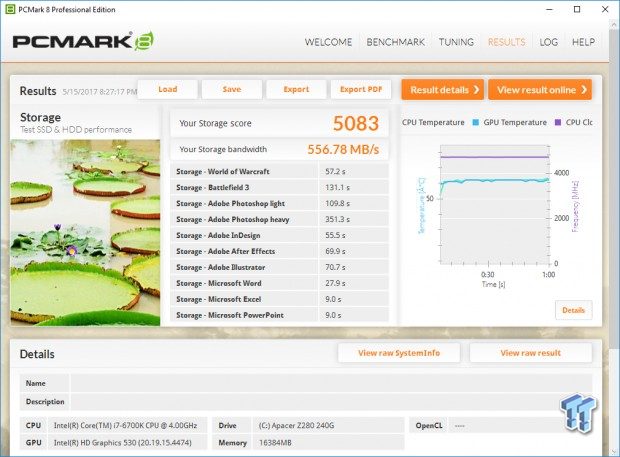
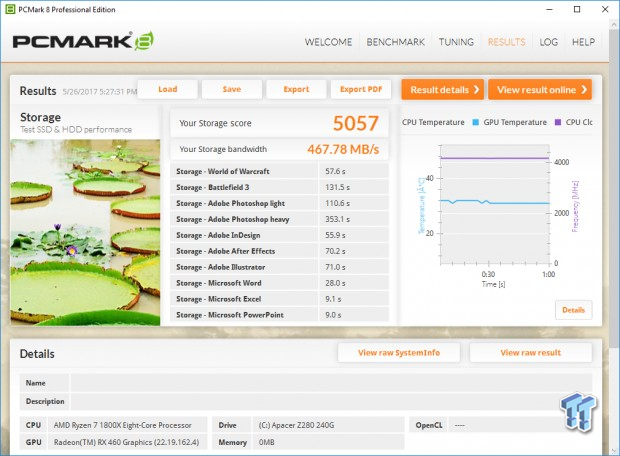
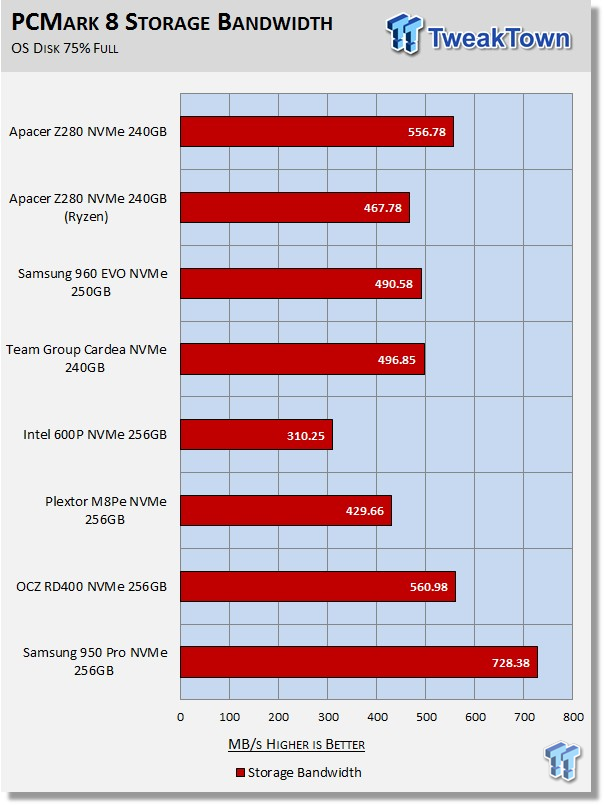
PCMark 8 is the most intensive moderate workload simulation we run. With respect to moderate consumer type workloads, this test is what we consider the best indicator of a drive's performance. Once again, the Z280 is able to outperform the 960 EVO when running on our Intel platform. The Z280 is even able to keep pace with OCZ's powerful RD400. We consider this to be the most important test we run, and only the no longer available 950 Pro is able to outperform the Z280.
BAPCo SYSmark 2014 SE System Performance
Version and / or Patch Used: 2.0.0.70
SYSmark 2014 SE is considered the gold standard for testing system performance because it is an application based benchmark. This test gives us the ultimate in real-world results because it utilizes actual applications running on the system, instead of playing back recorded traces. If you want to know what kind of impact a particular SSD will have on your system's overall performance; this test will show you.
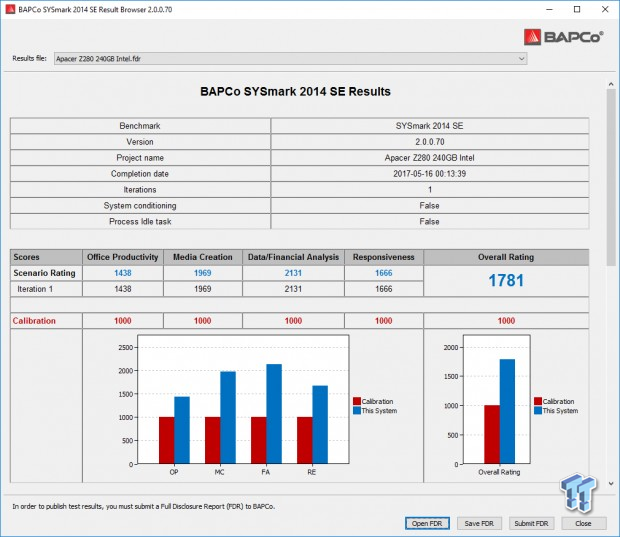
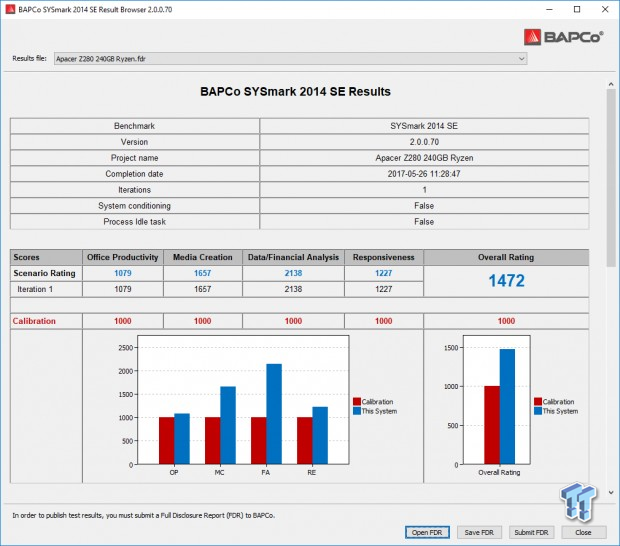
Disk performance has the greatest impact on the Responsiveness Score, so that is what we will focus on.

Our systems are much more powerful than the calibration system (1000-point baseline) used by BAPCo, so we ran an OCZ TL100 120GB SATA III SSD to establish a comparison point relative to our test systems. We will be running this test going forward and we will add drives to our chart as we test them.
It is important to keep in mind that with SYSmark 2014 SE a few points are a big deal when comparing one drive to another on the same platform.
It is important to remember that this score is not solely based on the storage device and therefore it isn't a totally accurate representation of how much more responsive one storage device is over another. To demonstrate this fact just compare the Z280's score running on Intel to its score with Ryzen.
We don't have a lot of SSDs for comparison yet, but we can say that the Apacer Z280 delivers stellar system responsiveness. From day one, E7 controlled SSDs have delivered a snappiness that differentiates it from most of the competition, which is the reason we are particularly fond of E7 controlled SSDs.
AMD has in the past stated that SYSmark is optimized for Intel, but both BAPCo and Intel deny that there is any built-in preference for Intel-based systems. We don't know who is right, but it is easy to see that Intel has a major advantage over AMD when testing with SYSmark.
Benchmarks (Secondary) - IOPS, Response & Transfer Rate
Iometer - Maximum IOPS
Version and / or Patch Used: Iometer 2014
We use Iometer to measure high queue depth performance. (No Partition)
Max IOPS Read
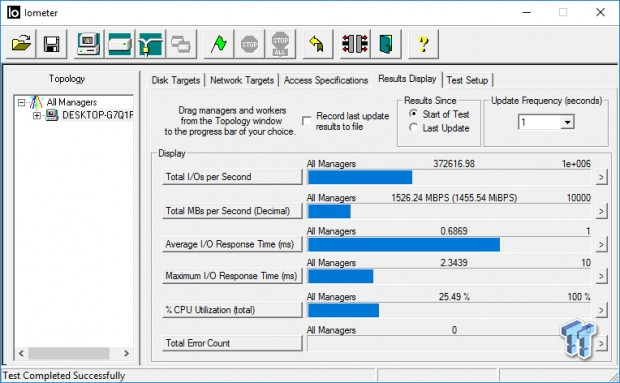
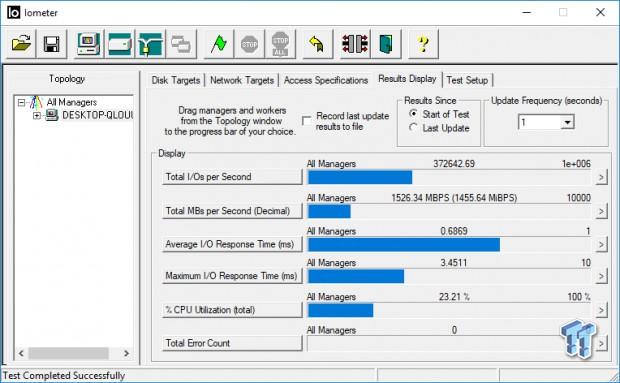
Max IOPS Write
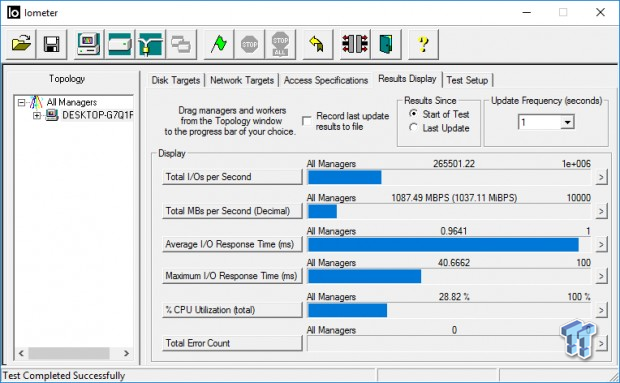
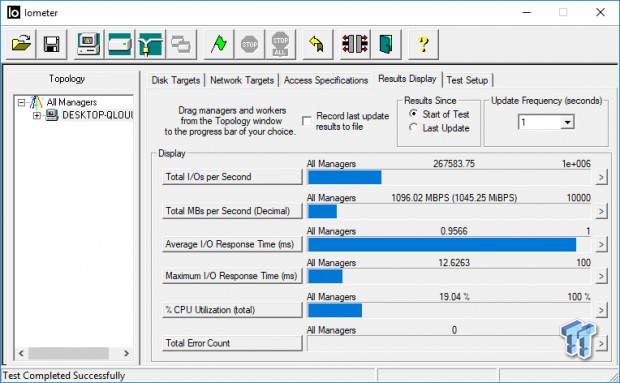
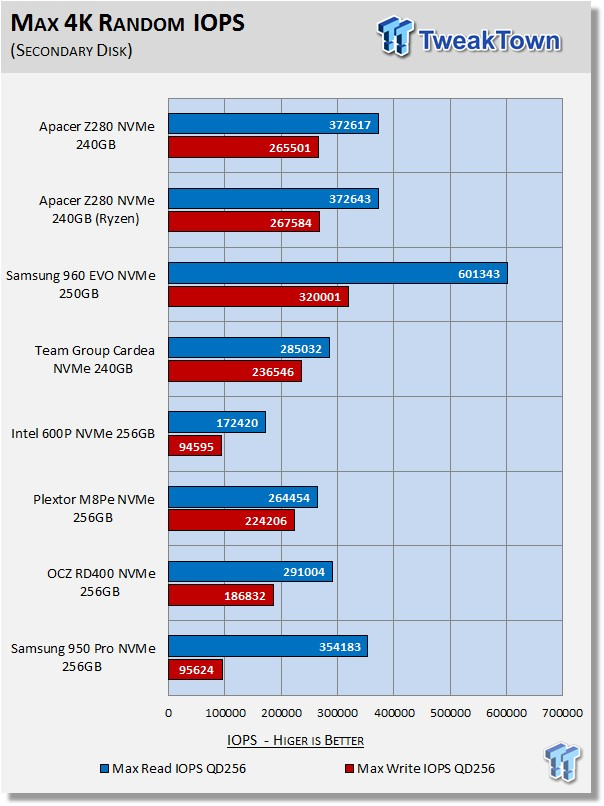
We test NVMe SSDs using eight threads at QD32, or QD256. We do this because we want to see what the drive can generate at its maximum attainable queue depth. Maximum random read/write performance is similar between the two platforms.
Iometer - Disk Response
Version and / or Patch Used: Iometer 2014
We use Iometer to measure disk response times. Disk response times are measured at an industry accepted standard of 4K QD1 for both write and read. Each test runs twice for 30 seconds consecutively, with a 5-second ramp-up before each test. We partition the drive/array as a secondary device for this testing.
Avg. Write Response
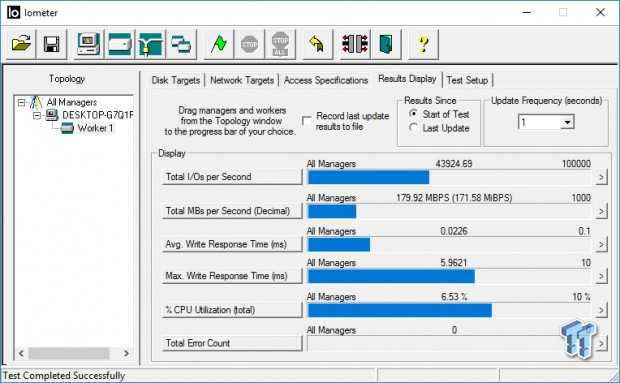
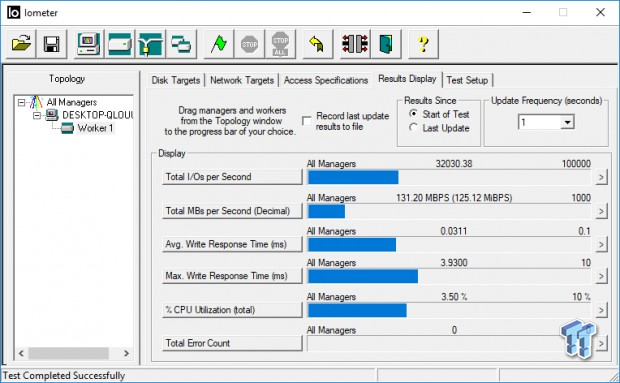
Avg. Read Response
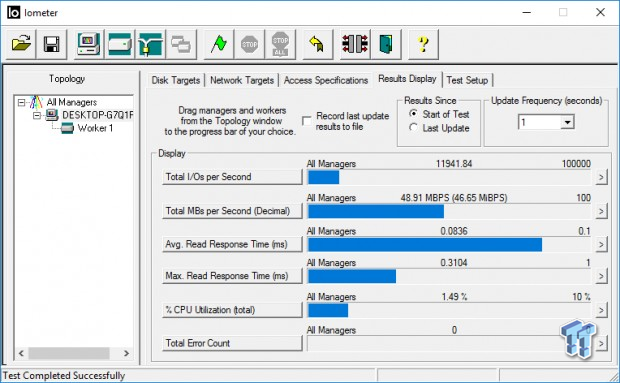
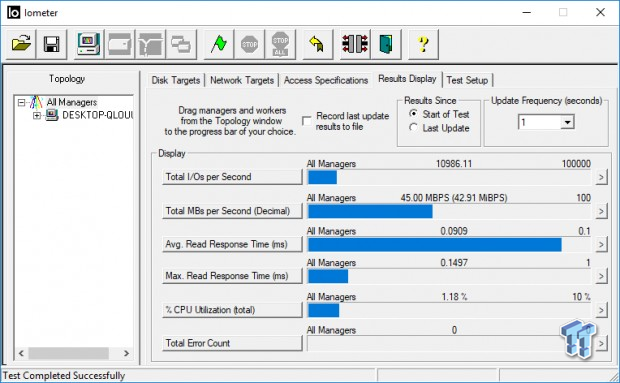
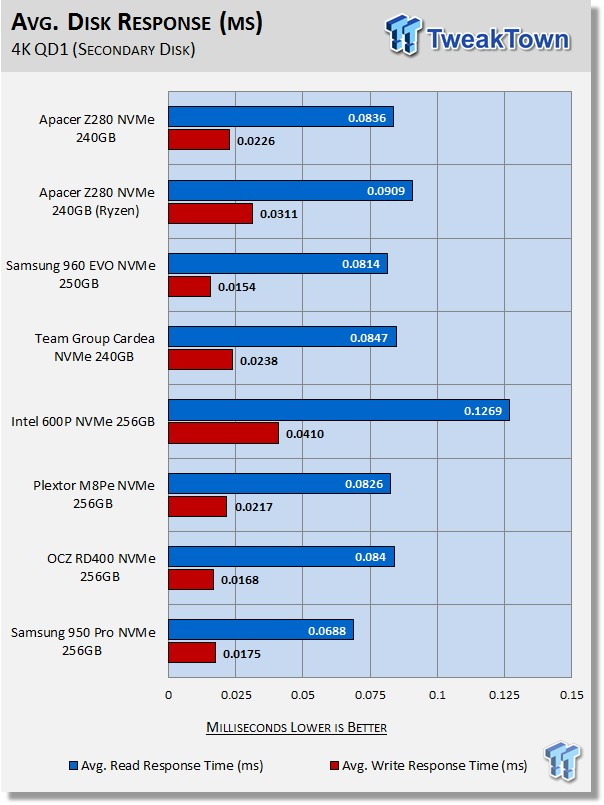
Disk response is significantly better (lower) on our Intel platform.
DiskBench - Transfer Rate
Version and / or Patch Used: 2.6.2.0
We use DiskBench to time a 28.6GB block (9,882 files in 1,247 folders) composed primarily of incompressible sequential and random data as it's transferred from our Toshiba RD400 1TB NVME SSD to our test drive. We then read from a 6GB zip file that's part of our 28.6GB data block to determine the test drive's read transfer rate. Our system is restarted prior to the read test to clear any cached data, ensuring an accurate test result.
Write Transfer Rate
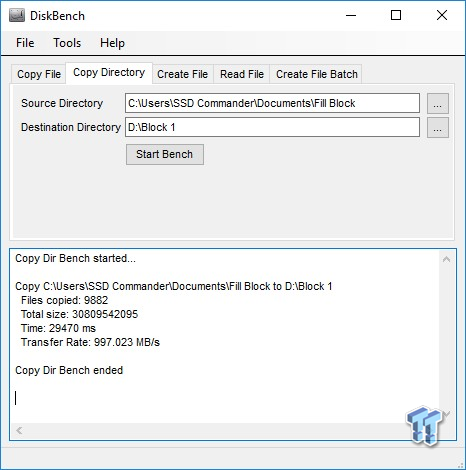
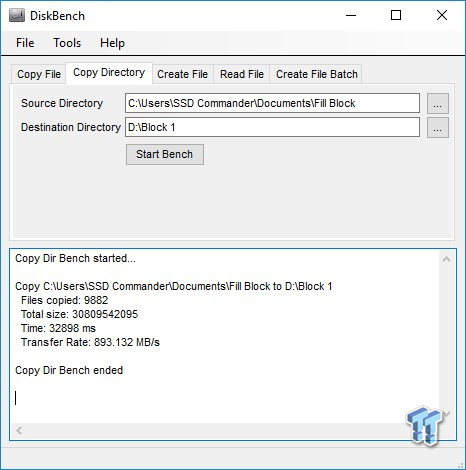
Read Transfer Rate
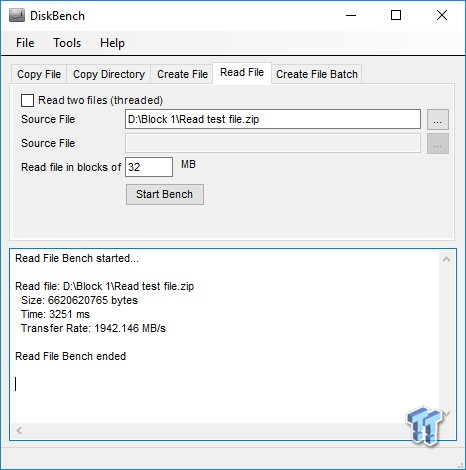
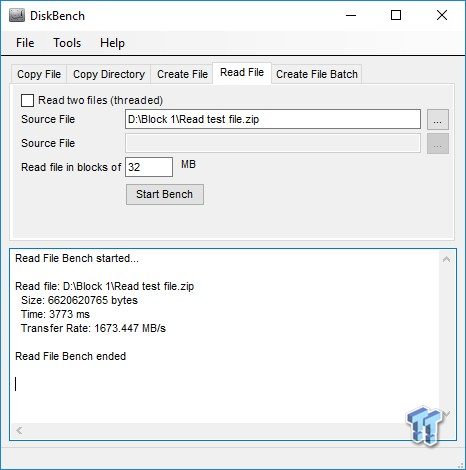
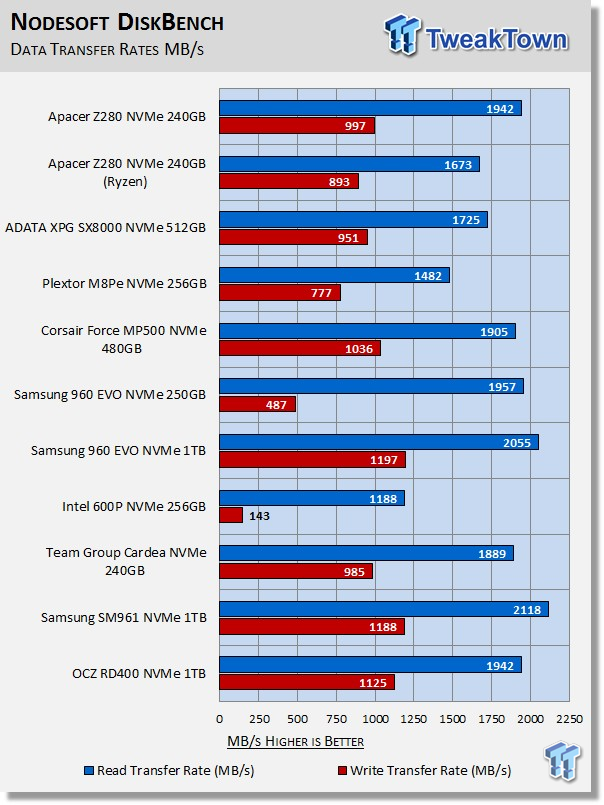
We recently upgraded our test system to Windows 10 build 14393. With that upgrade, write transfer rates almost doubled. The reason for this, as far as we know, is that CPU power switching modes have been relaxed on the latest version of Windows 10. We included the NVMe drives we've tested to date on this build of Windows 10. If you needed a good reason to upgrade to a newer version of Windows 10; this is a good reason.
Comparing the Z280 240GB to the 960 EVO 250GB shows clearly the sustained write advantage that MLC has over TLC at lower capacity points.
Benchmarks (Secondary Volume) – PCMark 8 Extended
Futuremark PCMark 8 Extended
Heavy Workload Model
PCMark 8's consistency test simulates an extended duration heavy workload environment. PCMark 8 has built-in, command line executed storage testing. The PCMark 8 Consistency test measures the performance consistency and the degradation tendency of a storage system.
The Storage test workloads are repeated. Between each repetition, the storage system is bombarded with a usage that causes degraded drive performance. In the first part of the test, the cycle continues until a steady degraded level of performance has been reached. (Steady State)
In the second part, the recovery of the system is tested by allowing the system to idle and measuring the performance after 5-minute long intervals. (Internal drive maintenance: Garbage Collection (GC)) The test reports the performance level at the start, the degraded steady-state, and the recovered state, as well as the number of iterations required to reach the degraded state and the recovered state.
We feel Futuremark's Consistency Test is the best test ever devised to show the true performance of solid state storage in an extended duration heavy workload environment. This test takes on average 13 to 17 hours to complete and writes somewhere between 450GB and 14,000GB of test data depending on the drive. If you want to know what an SSDs steady state performance is going to look like during a heavy workload, this test will show you.
Here's a breakdown of Futuremark's Consistency Test:
Precondition phase:
1. Write to the drive sequentially through up to the reported capacity with random data.
2. Write the drive through a second time (to take care of overprovisioning).
Degradation phase:
1. Run writes of random size between 8*512 and 2048*512 bytes on random offsets for 10 minutes.
2. Run performance test (one pass only).
3. Repeat 1 and 2 for 8 times, and on each pass increase the duration of random writes by 5 minutes.
Steady state phase:
1. Run writes of random size between 8*512 and 2048*512 bytes on random offsets for 50 minutes.
2. Run performance test (one pass only).
3. Repeat 1 and 2 for 5 times.
Recovery phase:
1. Idle for 5 minutes.
2. Run performance test (one pass only).
3. Repeat 1 and 2 for 5 times.
Storage Bandwidth
PCMark 8's Consistency test provides a ton of data output that we use to judge a drive's performance.
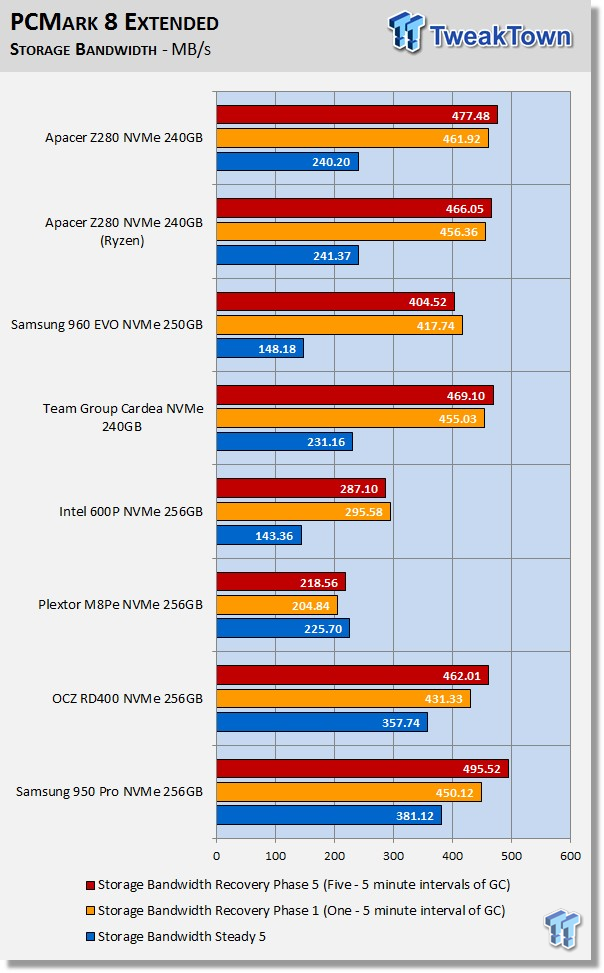
We consider steady-state bandwidth (the blue bar) our test that carries the most weight in ranking a drive/arrays heavy workload performance. Performance after Garbage Collection (GC) (the orange and red bars) is what we consider the second most important consideration when ranking a drive's performance.
The 240GB Z280 easily outperforms the 250GB 960 EVO across the board on both platforms. We would like to see better steady-state performance, but the drive recovers incredibly well and delivers excellent overall performance on both our Intel and Ryzen platforms.
Storage Bandwidth Per Phase
We chart our test subject's storage bandwidth as reported at each of the test's 18 trace iterations. This gives us a good visual perspective of how our test subjects perform as testing progresses. This chart sheds more light on how the drives perform as they progress through the testing phases.
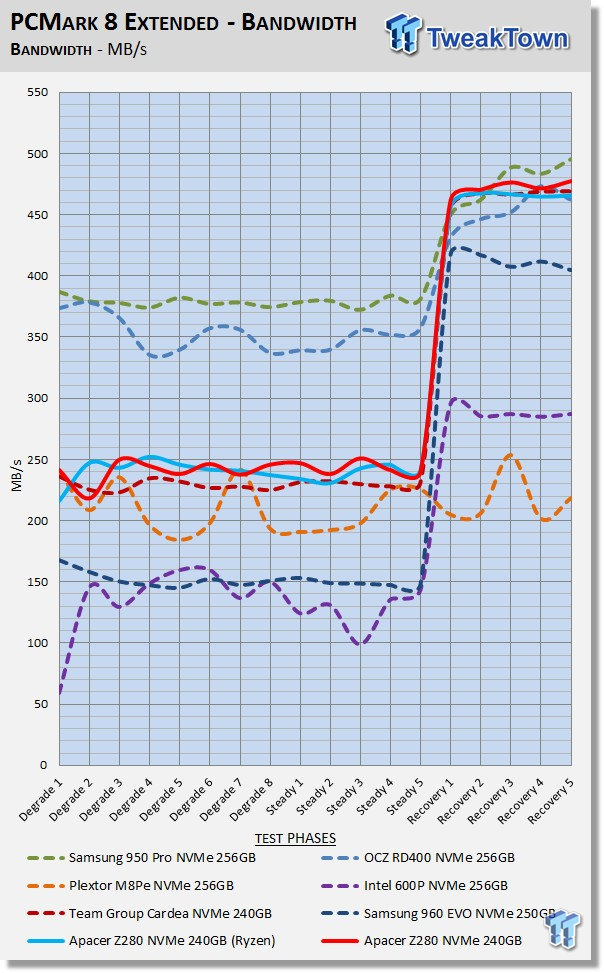
Total Access Time (Latency)
We chart the total time the disk is accessed as reported at each of the test's 18 trace iterations. This helps shed some light on how the drive performs at each of the 18 phases of this test.
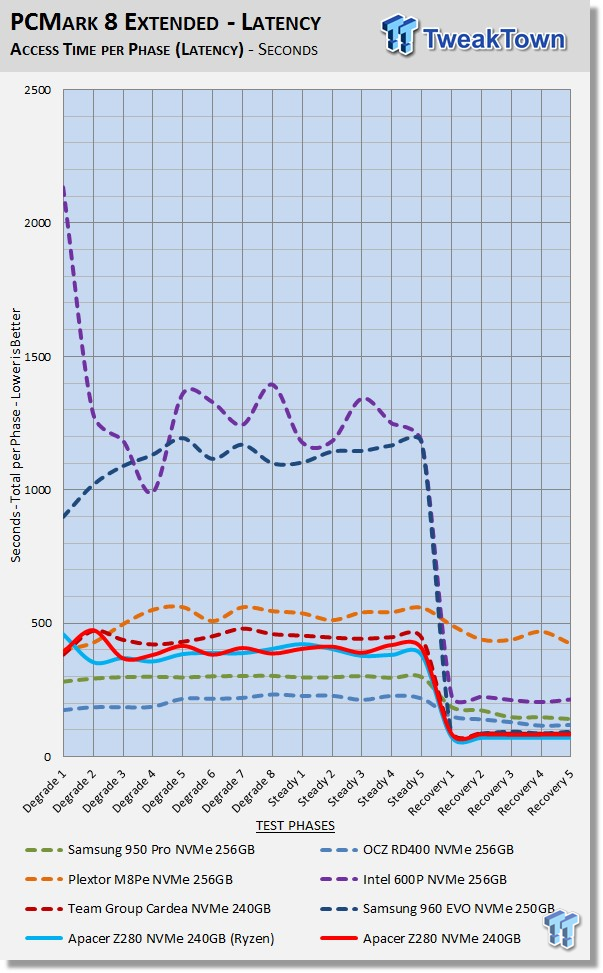
Disk Busy Time
Disk Busy Time is how long the disk is busy working. We chart the total time the disk is working as reported at each of the tests 18 trace iterations.
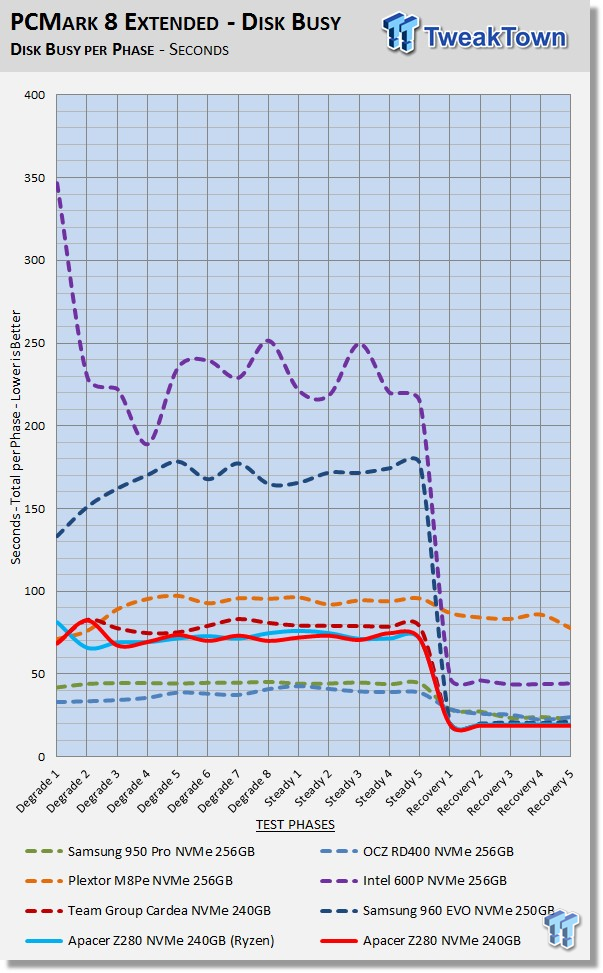
Data Written
We measure the total amount of random data that our test drive/array is capable of writing during the degradation phases of the consistency test. Pre-conditioning data is not included in the total. The total combined time that degradation data is written to the drive/array is 470 minutes. This can be very telling. The better a drive/array can process a continuous stream of random data; the more data will be written.
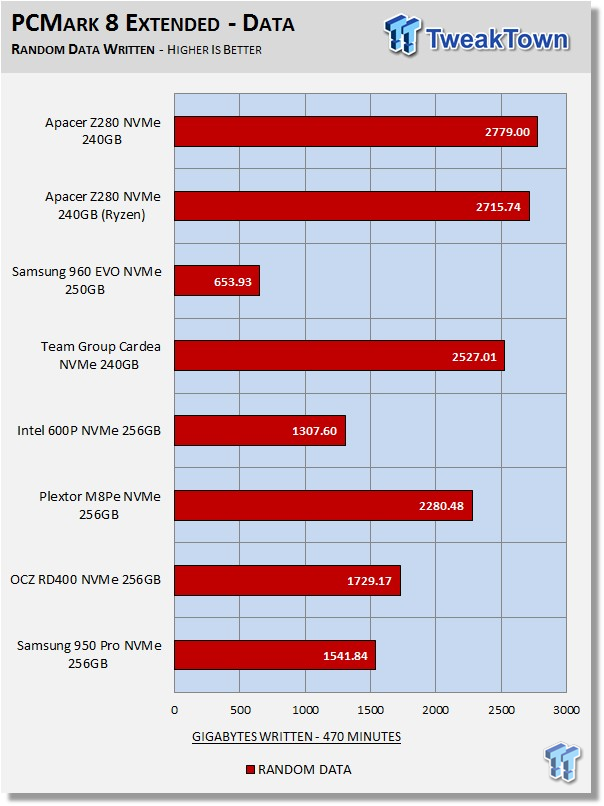
Overprovisioning and write latency are the biggest factors that determine the outcome of this portion of the test. Here we find the Z280 dominating the competition.
Benchmarks (Secondary Volume) – 70/30 Mixed Workload
70/30 Mixed Workload Test (Sledgehammer)
Version and / or Patch Used: Iometer 2014
Heavy Workload Model
This test hammers a drive so hard we've dubbed it "Sledgehammer". Our 70/30 Mixed Workload test is designed to simulate a heavy-duty enthusiast/workstation steady-state environment. We feel that a mix of 70% read/30% write, full random 4K transfers best represents this type of user environment. Our test allows us to see the drive enter into and reach a steady state as the test progresses.
Phase one of the test preconditions the drive for 1 hour with 128K sequential writes. Phase two of the test runs a 70% read/30% write, full random 4K transfer workload on the drive for 1 hour. We log and chart (phase two) IOPS data at 5-second intervals for 1 hour (720 data points). 60 data points = 5 minutes.

What we like about this test is that it reflects reality. Everything lines up, as it should. Consumer drives don't outperform Enterprise-Class SSDs that were designed for enterprise workloads. Consumer drives based on old technology are not outperforming modern Performance-Class SSDs, etc.
The Z280 handles this brutal test quite well on both platforms. The Z280 digests this brutal test better than the competition with the exception of Plextor's M8Pe.
Maxed-Out Performance (MOP)
This testing is just to see what the drive is capable of in an FOB (Fresh Out of Box) state under optimal conditions. We are utilizing empty volumes of Windows 10 and Windows Server 2012 R2 64-bit for this testing.
Windows 10 MOP (Intel)
Apacer Z280 240GB M.2 NVMe PCIe SSD
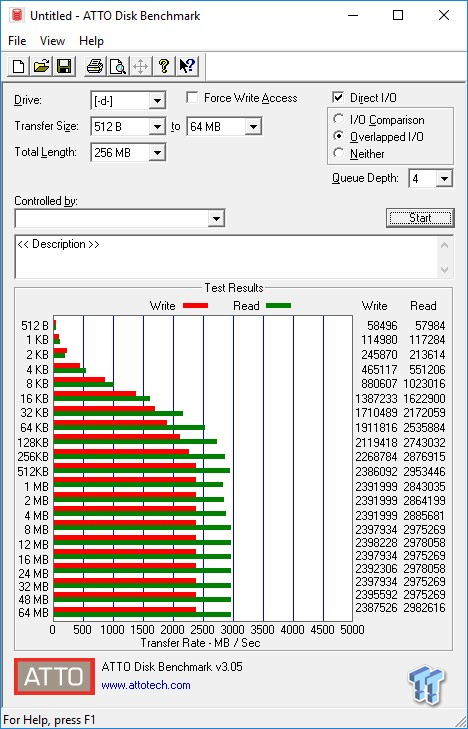
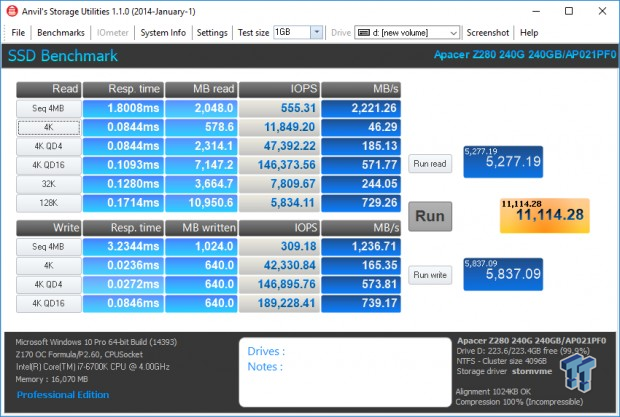
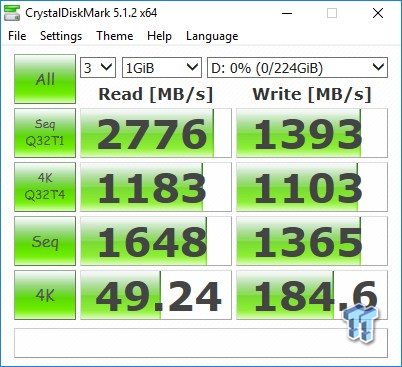
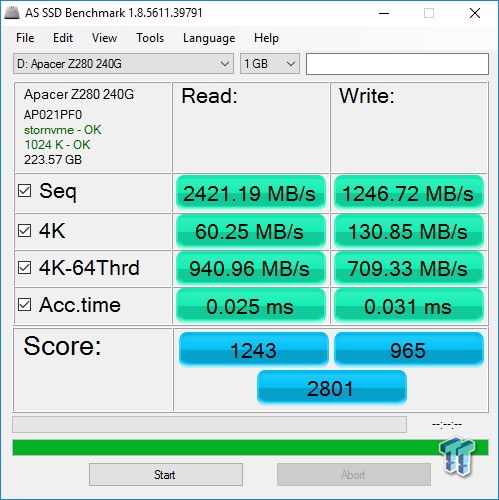
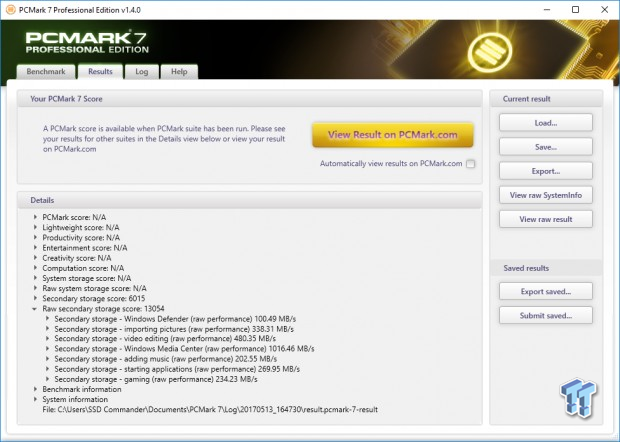
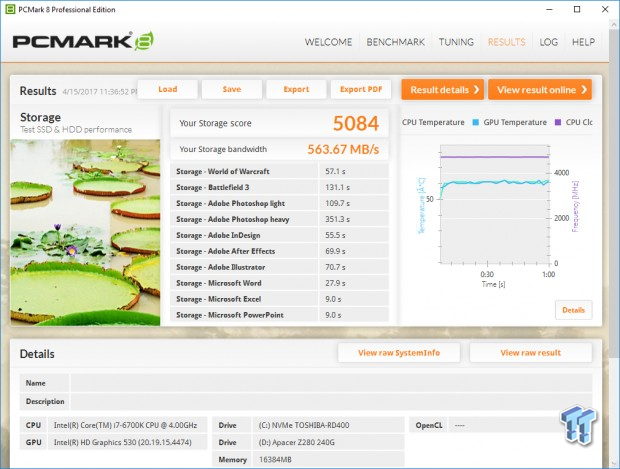
Windows 10 MOP (AMD)
TeamGroup T-Force Cardea 240GB M.2 NVMe PCIe SSD
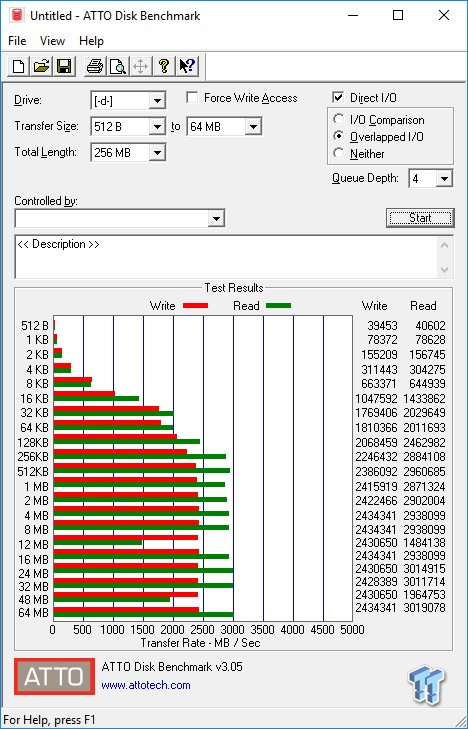
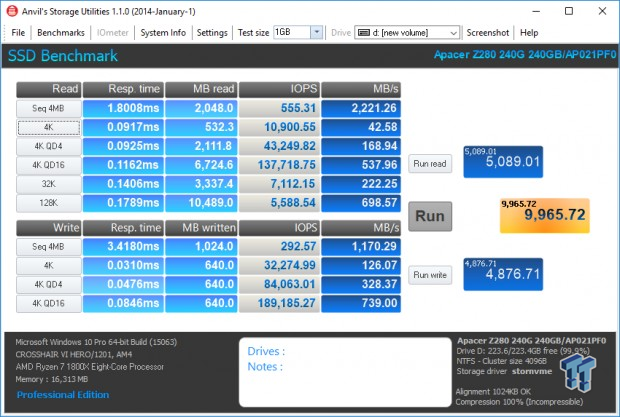
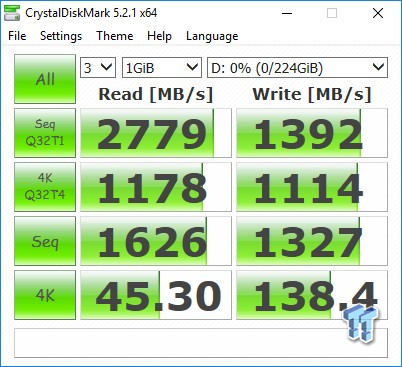
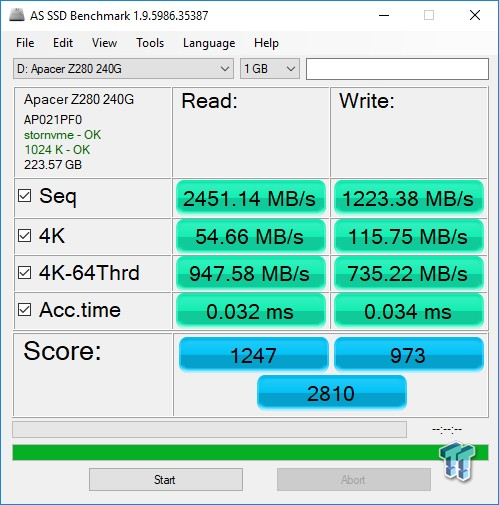
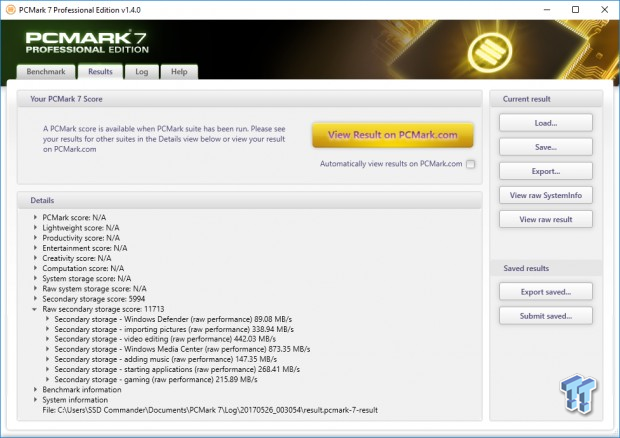
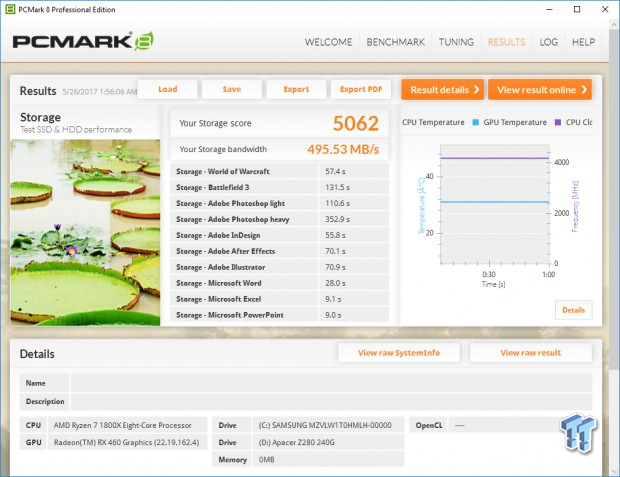
Windows Server 2012 R2 MOP (Intel only)
Apacer Z280 240GB M.2 NVMe PCIe SSD
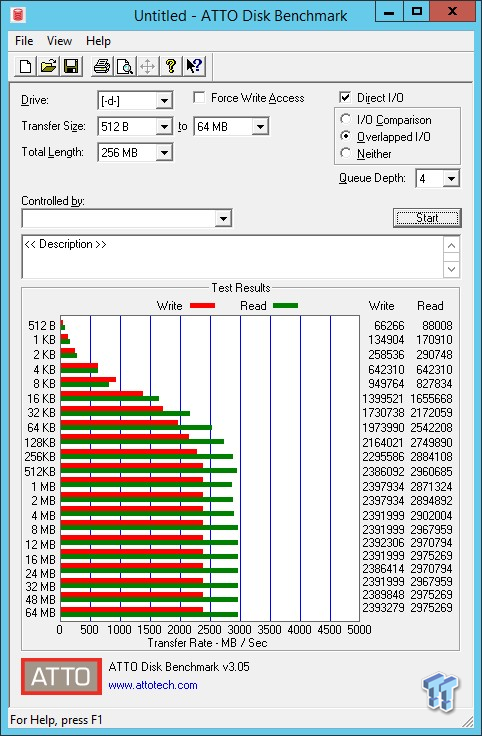
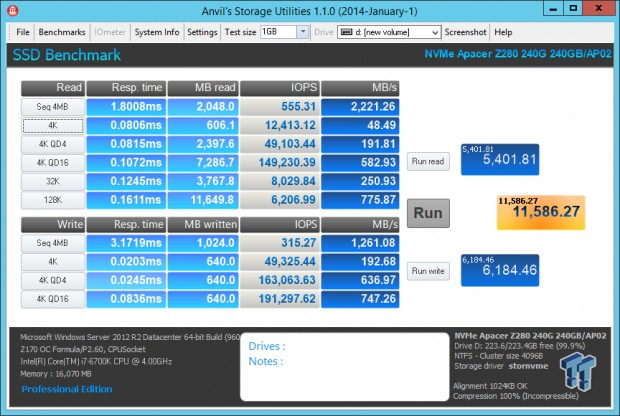
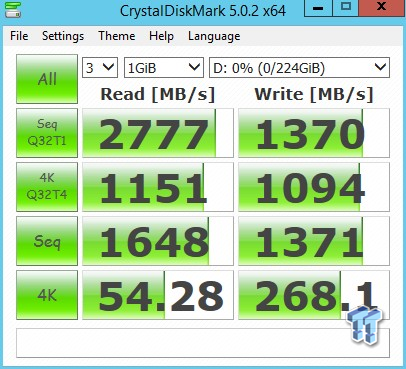

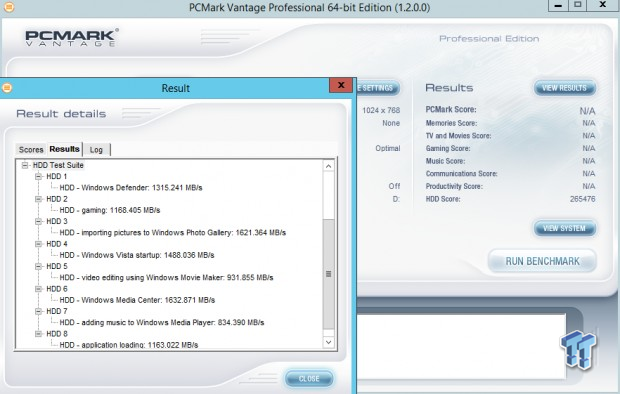
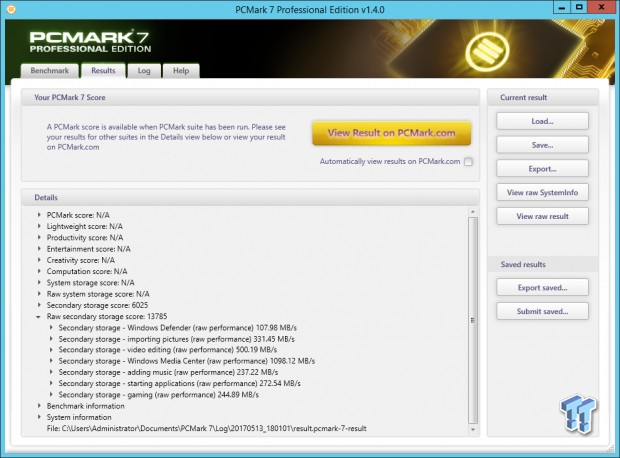
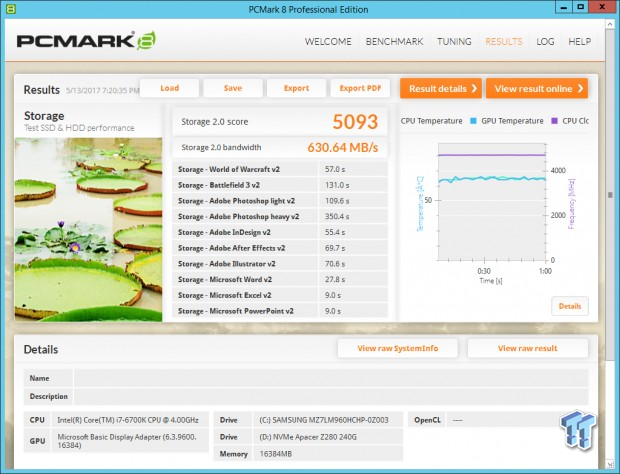
Final Thoughts
Apacer isn't a well-known brand in the SSD world, but they are making a big push to become so. If the Z280 is any indication of what they plan on bringing to the table, then we think they will be quite successful at expanding their customer base. The Z280 is one of the most affordable NVMe SSDs on the market and it is in our opinion one of the best.
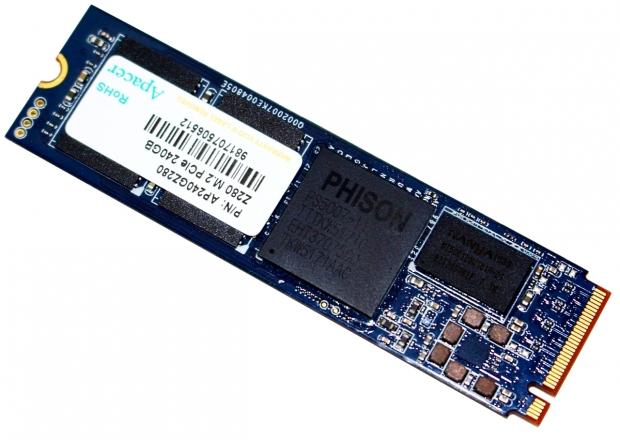
Low cost and top-flight performance is always a winning combination. It's more than just the performance that the Z280 has to offer, it also offers class-leading endurance and the goodness of MLC flash which is becoming a rarity these days.
In terms of pricing, we feel the 240GB Z280 is a huge value at $123.00 especially in the midst of a NAND flash shortage. We often see lesser SSDs going for a lot more money. In terms of performance, the Z280's MLC flash array is a cut above TLC flash of any flavor which is why it performs better than the 250GB 960 EVO when running common consumer workloads.
We can really only find two faults with the Z280. We feel that any SSD with a MLC flash array and TBW as high as the Z280 should be backed by a 5-year warranty. But this is a minor gripe because most users will upgrade within 3 years. The other gripe is no SSD toolbox, which is very useful for novice and experienced SSD users alike.
Because TweakTown tests SSDs with the drive running as our system (OS) disk we are in a relatively unique position to comment on what matters most - user experience. In terms of user experience, the Z280 gives us exactly what are looking for. System responsiveness that is up there with the most highly regarded SSDs on the market and boot times that are as good as they get. Overall a Tier-1 user experience for a value price. Apacer's Z280 240GB M.2 NVMe PCIe SSD is TweakTown recommended.
Pros:
- Moderate Workload Performance
- Premium Components
- Low Cost
Cons:
- No SSD Management Tool Box
- 3-Year Warranty

